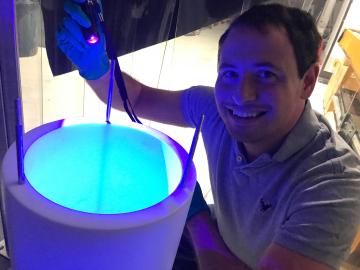
Filter News
Area of Research
- (-) Neutron Science (21)
- (-) Supercomputing (63)
- Advanced Manufacturing (1)
- Biology and Environment (50)
- Biology and Soft Matter (1)
- Building Technologies (3)
- Computational Engineering (1)
- Computer Science (3)
- Electricity and Smart Grid (3)
- Energy Frontier Research Centers (1)
- Energy Science (101)
- Functional Materials for Energy (1)
- Fusion and Fission (27)
- Fusion Energy (15)
- Isotopes (25)
- Materials (92)
- Materials for Computing (8)
- Mathematics (1)
- National Security (13)
- Nuclear Science and Technology (14)
- Quantum information Science (2)
- Sensors and Controls (1)
News Topics
- (-) Buildings (4)
- (-) Frontier (33)
- (-) Fusion (2)
- (-) Grid (5)
- (-) Isotopes (2)
- (-) Nanotechnology (19)
- (-) Physics (17)
- 3-D Printing/Advanced Manufacturing (10)
- Advanced Reactors (2)
- Artificial Intelligence (40)
- Big Data (23)
- Bioenergy (14)
- Biology (16)
- Biomedical (28)
- Biotechnology (2)
- Chemical Sciences (7)
- Clean Water (2)
- Composites (1)
- Computer Science (99)
- Coronavirus (19)
- Critical Materials (3)
- Cybersecurity (9)
- Energy Storage (14)
- Environment (29)
- Exascale Computing (26)
- Fossil Energy (1)
- High-Performance Computing (44)
- Hydropower (1)
- Machine Learning (17)
- Materials (28)
- Materials Science (33)
- Mathematics (2)
- Microscopy (8)
- Molten Salt (1)
- National Security (8)
- Neutron Science (122)
- Nuclear Energy (7)
- Partnerships (1)
- Polymers (3)
- Quantum Computing (20)
- Quantum Science (30)
- Security (7)
- Simulation (16)
- Software (1)
- Space Exploration (5)
- Summit (43)
- Transportation (10)
Media Contacts

Scientists at ORNL and the University of Tennessee, Knoxville, have found a way to simultaneously increase the strength and ductility of an alloy by introducing tiny precipitates into its matrix and tuning their size and spacing.

The Department of Energy’s Office of Science has selected five Oak Ridge National Laboratory scientists for Early Career Research Program awards.

At the Department of Energy’s Oak Ridge National Laboratory, scientists use artificial intelligence, or AI, to accelerate the discovery and development of materials for energy and information technologies.

The U.S. Department of Energy’s Innovative and Novel Computational Impact on Theory and Experiment, or INCITE, program is seeking proposals for high-impact, computationally intensive research campaigns in a broad array of science, engineering and computer science domains.

The COHERENT particle physics experiment at the Department of Energy’s Oak Ridge National Laboratory has firmly established the existence of a new kind of neutrino interaction.

Since the 1930s, scientists have been using particle accelerators to gain insights into the structure of matter and the laws of physics that govern our world.

A new tool from Oak Ridge National Laboratory can help planners, emergency responders and scientists visualize how flood waters will spread for any scenario and terrain.

Six scientists at the Department of Energy’s Oak Ridge National Laboratory were named Battelle Distinguished Inventors, in recognition of obtaining 14 or more patents during their careers at the lab.

The annual Director's Awards recognized four individuals and teams including awards for leadership in quantum simulation development and application on high-performance computing platforms, and revolutionary advancements in the area of microbial

Two scientists with the Department of Energy’s Oak Ridge National Laboratory have been elected fellows of the American Physical Society.


